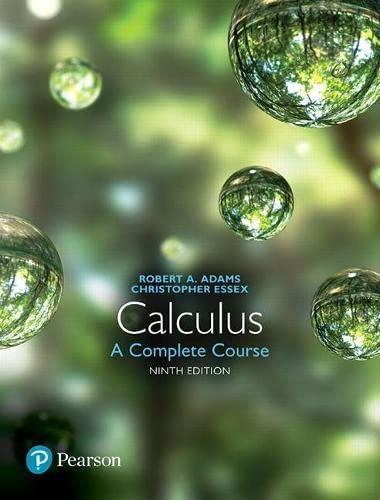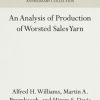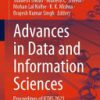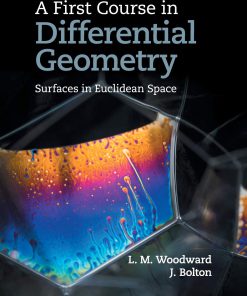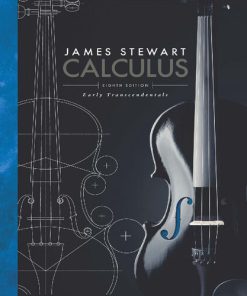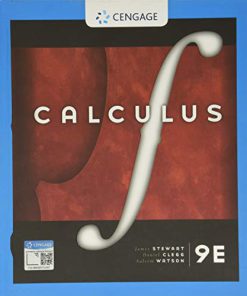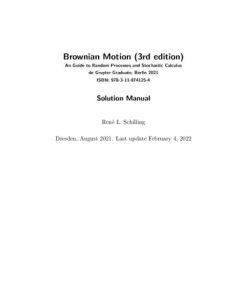Solutions Manual for Calculus A Complete Course 9th Edition by Robert Adams ISBN 0134154363 9780134154367
$50.00 Original price was: $50.00.$25.00Current price is: $25.00.
Solutions Manual for Calculus: A Complete Course 9th Edition by Robert Adams – Ebook PDF Instant Download/Delivery: 0134154363, 978-0134154367
Full download Calculus: A Complete Course 9th Edition after payment
Product details:
ISBN 10: 0134154363
ISBN 13: 978-0134154367
Author: Robert Adams
Calculus: A Complete Course 9th Edition:
Proven in North America and abroad, this classic text has earned a reputation for excellent accuracy and mathematical rigour. Previous editions have been praised for providing complete and precise statements of theorems, using geometric reasoning in applied problems, and for offering a range of applications across the sciences. Written in a clear, coherent, and readable form, Calculus: A Complete Course makes student comprehension a clear priority.
KEY TOPICS:
Limits and Continuity; Differentiation; Transcendental Functions; More Applications of Differentiation; Integration; Techniques of Integration; Applications of Integration; Conics, Parametric Curves, and Polar Curves; Sequence, Series, and Power Series; Vectors and Coordinate Geometry in 3-Space; Vector Functions and Curves; Partial Differentiation; Applications of Partial Derivatives; Multiple Integration; Vector Fields; Vector Calculus; Differential forms and Exterior Calculus; Ordinary Differential Equations
MARKET:
Appropriate for the three-semester calculus course.
Calculus: A Complete Course 9th Edition Table of contents:
1. Limits and Continuity
1.1. Examples of Velocity, Growth Rate, and Area
-
Average Velocity and Instantaneous Velocity
-
The Growth of an Algal Culture
-
The Area of a Circle
1.2. Limits of Functions
-
One-Sided Limits
-
Rules for Calculating Limits
-
The Squeeze Theorem
1.3. Limits at Infinity and Infinite Limits
-
Limits at Infinity
-
Limits at Infinity for Rational Functions
-
Infinite Limits
-
Using Maple to Calculate Limits
1.4. Continuity
-
Continuity at a Point
-
Continuity on an Interval
-
Continuous Functions on Closed, Finite Intervals
1.5. The Formal Definition of Limit
-
Using the Definition of Limit to Prove Theorems
-
Other Kinds of Limits
2. Differentiation
2.1. Tangent Lines and Their Slopes
-
Normals
2.2. The Derivative
-
Some Important Derivatives
-
Leibniz Notation
-
Differentials
2.3. Differentiation Rules
-
Sums and Constant Multiples
-
The Product Rule
-
The Reciprocal Rule
-
The Quotient Rule
2.4. The Chain Rule
-
Finding Derivatives with Maple
-
Building the Chain Rule into Differentiation Formulas
-
Proof of the Chain Rule (Theorem 6)
2.5. Derivatives of Trigonometric Functions
-
Some Special Limits
-
The Derivatives of Sine and Cosine
-
The Derivatives of the Other Trigonometric Functions
2.6. Higher-Order Derivatives
2.7. Using Differentials and Derivatives
-
Approximating Small Changes
-
Average and Instantaneous Rates of Change
2.8. The Mean-Value Theorem
-
Increasing and Decreasing Functions
2.9. Implicit Differentiation
-
Higher-Order Derivatives
-
The General Power Rule
2.10. Antiderivatives and Initial-Value Problems
-
Antiderivatives
-
The Indefinite Integral
-
Differential Equations and Initial-Value Problems
2.11. Velocity and Acceleration
-
Velocity and Speed
-
Acceleration
-
Falling Under Gravity
3. Transcendental Functions
3.1. Inverse Functions
-
Inverting Non–One-to-One Functions
-
Derivatives of Inverse Functions
3.2. Exponential and Logarithmic Functions
-
Exponentials
-
Logarithms
3.3. The Natural Logarithm and Exponential
-
The Natural Logarithm
-
The Exponential Function
3.4. Growth and Decay
-
Exponential Growth and Decay Models
-
Interest on Investments
-
Logistic Growth
3.5. The Inverse Trigonometric Functions
-
The Inverse Sine (or Arcsine) Function
-
The Inverse Tangent (or Arctangent) Function
3.6. Hyperbolic Functions
-
Inverse Hyperbolic Functions
3.7. Second-Order Linear DEs with Constant Coefficients
-
Recipe for Solving ay” + by’ + cy = 0
-
Simple Harmonic Motion
-
Damped Harmonic Motion
4. More Applications of Differentiation
4.1. Related Rates
-
Procedures for Related-Rates Problems
4.2. Finding Roots of Equations
-
Discrete Maps and Fixed-Point Iteration
-
Newton’s Method
4.3. Indeterminate Forms
-
L’Hopital’s Rule
4.4. Extreme Values
-
Maximum and Minimum Values
-
Critical Points, Singular Points, and Endpoints
4.5. Concavity and Inflections
-
The Second Derivative Test
4.6. Sketching the Graph of a Function
-
Asymptotes
4.7. Graphing with Computers
-
Numerical Monsters and Computer Graphing
4.8. Extreme-Value Problems
-
Procedure for Solving Extreme-Value Problems
4.9. Linear Approximations
-
Approximating Values of Functions
-
Error Analysis
4.10. Taylor Polynomials
-
Taylor’s Formula
-
Big-O Notation
4.11. Roundoff Error, Truncation Error, and Computers
-
Taylor Polynomials in Maple
5. Integration
5.1. Sums and Sigma Notation
-
Evaluating Sums
5.2. Areas as Limits of Sums
-
The Basic Area Problem
-
Some Area Calculations
5.3. The Definite Integral
-
Partitions and Riemann Sums
-
The Definite Integral
5.4. Properties of the Definite Integral
-
A Mean-Value Theorem for Integrals
5.5. The Fundamental Theorem of Calculus
5.6. The Method of Substitution
-
Trigonometric Integrals
5.7. Areas of Plane Regions
-
Areas Between Two Curves
6. Techniques of Integration
6.1. Integration by Parts
-
Reduction Formulas
6.2. Integrals of Rational Functions
-
Linear and Quadratic Denominators
-
Partial Fractions
6.3. Inverse Substitutions
-
The Inverse Trigonometric Substitutions
6.4. Other Methods for Evaluating Integrals
-
The Method of Undetermined Coefficients
6.5. Improper Integrals
-
Improper Integrals of Type I
-
Improper Integrals of Type II
6.6. The Trapezoid and Midpoint Rules
-
The Trapezoid Rule
-
The Midpoint Rule
6.7. Simpson’s Rule
7. Applications of Integration
7.1. Volumes by Slicing—Solids of Revolution
-
Volumes by Slicing
-
Solids of Revolution
7.2. More Volumes by Slicing
7.3. Arc Length and Surface Area
-
Arc Length
-
The Arc Length of the Graph of a Function
-
Areas of Surfaces of Revolution
7.4. Mass, Moments, and Centre of Mass
-
Mass and Density
-
Moments and Centres of Mass
7.5. Centroids
-
Pappus’s Theorem
7.6. Other Physical Applications
-
Hydrostatic Pressure
-
Work
-
Potential Energy and Kinetic Energy
7.7. Applications in Business, Finance, and Ecology
-
The Present Value of a Stream of Payments
-
The Economics of Exploiting Renewable Resources
7.8. Probability
-
Discrete Random Variables
-
Expectation, Mean, Variance, and Standard Deviation
7.9. First-Order Differential Equations
-
Separable Equations
-
First-Order Linear Equations
People also search for Calculus: A Complete Course 9th Edition:
robert a.adams calculus a complete course
ap calculus a complete course
calculus a complete course 10th edition pdf
calculus ab full course
adams calculus a complete course solutions
Tags:
Robert Adams,Calculus,Complete Course
You may also like…
Mathematics - Geometry and Topology
Computers - Programming
Mathematics - Analysis
Mathematics - Others
Mathematics - Functional Analysis
Mathematics - Probability
Uncategorized
Computers - Home Computer User & Beginner
The Complete iPad iPadOs 15 Manual 9th Edition Black Dog Media

